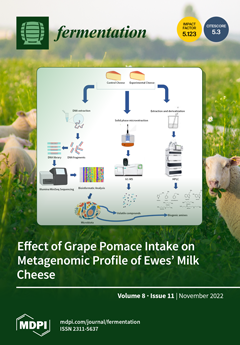Here, we report on the synthesis of zinc oxide nanoparticles (ZnO NPs) and selenium nanowires (Se NWs) using microbial exopolysaccharides (EPS) as a mediator and then examine their antibacterial and ecotoxicity effects in vitro and in vivo, respectively. At 100 µg/mL, EPS, EPS-ZnO
[...] Read more.
Here, we report on the synthesis of zinc oxide nanoparticles (ZnO NPs) and selenium nanowires (Se NWs) using microbial exopolysaccharides (EPS) as a mediator and then examine their antibacterial and ecotoxicity effects in vitro and in vivo, respectively. At 100 µg/mL, EPS, EPS-ZnO NPs, and EPS-Se NWs all exhibited potent in vitro antibacterial properties, drastically inhibiting the development of aquatic Gram
(-) pathogens. In addition, antibiofilm studies using a microscope revealed that EPS, EPS-ZnO NPs, and EPS-Se NWs at 75 µg/mL prevented biofilm development. Furthermore, the in vivo toxicity was carried out via
Danio rerio embryos and
Ceriodaphnia cornuta.
Danio rerio embryos were determined at different time intervals (6 hpf, 12 hpf, 24 hpf and 48 hpf). The maximum survival rate (100%) was obtained in a control group. Correspondingly, EPS, EPS-ZnO NPs and EPS-Se NWs treated embryos showed a considerable survival rate with 93.3%, 86.7% and 77.2%, respectively, at 100 µg/mL for 48 hpf. The total mortality of
C. cornuta was seen at 100 µg/mL, with 56.7% in EPS, 60.0% in EPS-ZnO NPs, and 70.0% in EPS-Se NWs. For
C. cornuta, the LC
50 values for EPS, EPS-ZnO NPs, and EPS-Se NWs were 90.32, 81.99, and 62.99 µg/mL, respectively. Under a microscope, morphological alterations in
C. cornuta were analyzed. After 24 h, an amount of dark substance was seen in the guts of
C. cornuta exposed to 100 µg/mL, but in the control group, all of the living
C. cornuta were swimming as usual. Our results show that EPS and EPS-ZnO NPs were less harmful than EPS-Se NWs, and that they were successfully employed to shield freshwater crustaceans from the toxins in aquatic environments.
Full article





